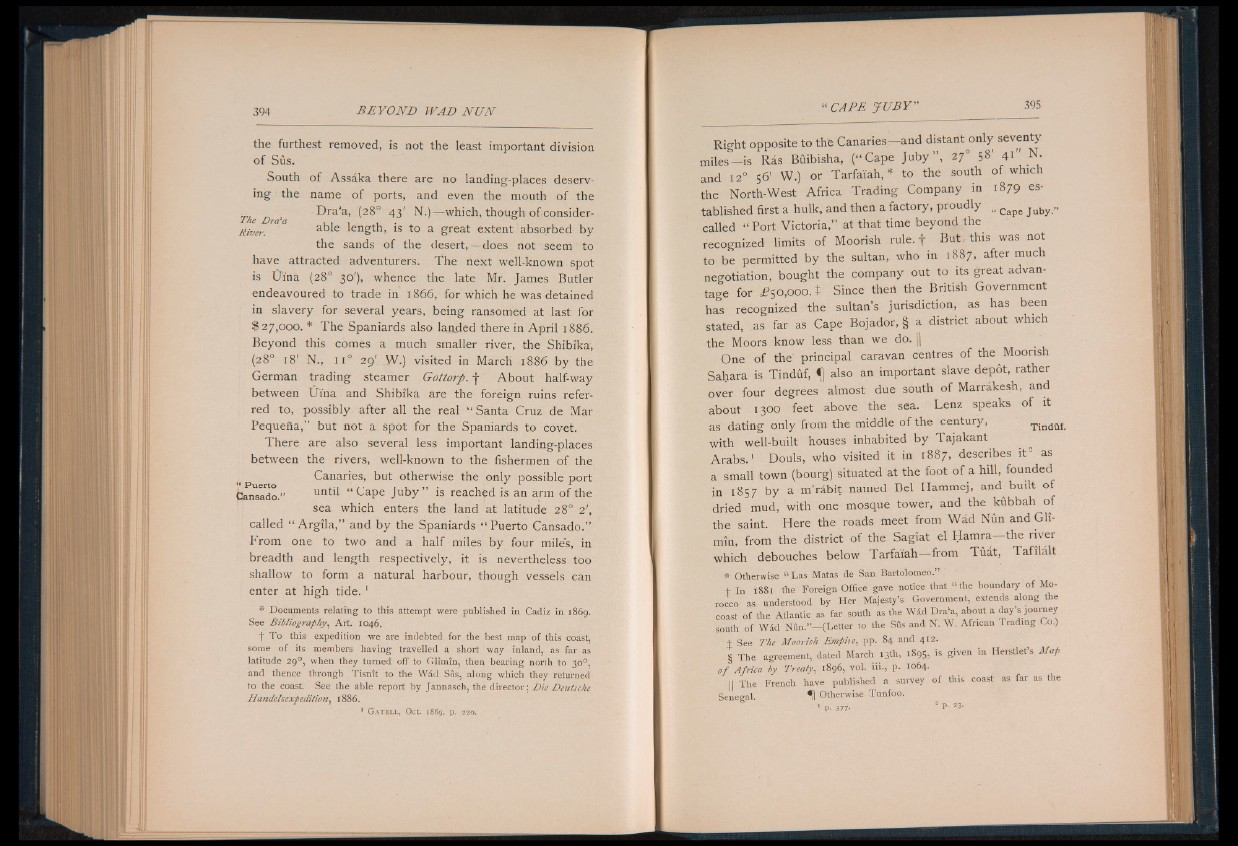
394 B E YO N D WAD N U N
the furthest removed, is not the least important division
of Sus.
South of Assaka there are no landing-places deserving
the name of ports, and even the mouth of the
fi Dra'a, (28o 43' N.)— which, though of consider-
The Dra a 1 1 1 1
River. able length> it« to a great extent absorbed by
the sands of the desert,— does not seem to
have attracted adventurers. The next well-known spot
is Úina (28o 30'), whence the late Mr. James Butler
endeavoured to trade in 1866, for which he was detained
in slavery for several years, being ransomed at last for
$27,000. * The Spaniards also landed there in April 1886.
Beyond this comes a much smaller river, the Shibika,
(28o 18' N., i i ° 29' W.) visited in March 1886 by the
German trading steamer Gottorp. f About half-way
between Uina and Shibika are the foreign ruins referred
to, possibly after all the real “ Santa Cruz de Mar
Pequeña,” but not a spot for the Spaniards to covet.
There are also several less important landing-places
between the rivers, well-known to the fishermen of the
Canaries, but otherwise the only possible port
Cansado.” unt^ “ ^aPe Juby ” reacbed is an arm of the
sea which enters the land at latitude 28o 2',
called “ Argila,” and by the Spaniards “ Puerto Cansado.”
Prom one to two and a half miles by four miles, in
breadth and length respectively, it is nevertheless too
shallow to form a natural harbour, though vessels can
enter at high tide. 1
* Documents relating to this attempt were published in Cadiz in 1869.
See Bibliography, Art. 1046.
t To this expedition we are indebted for the best map of this coast,
some of its members having travelled a short way inland, as far as
latitude 290, when they turned off to Glimin, then bearing north to 30o,
and thence through Tisnit to the Wád Sus, along which they returned
to the coast. See the able report by Jannasch, the director; Die Deutsche
Handelsexpedition, 1886.
“ CAPE J U B Y ” 395
Right opposite to the Canaries— and distant only seventy
miles—is Ras Buibisha, (“ Cape Juby” , 270 58 41 N.
and 120 56' W.) or Tarfaiah, * to the south of which
the North-West Africa Trading Company in 1879 established
first a hulk, and then a factory, proudly “ Cape Juby.”
called “ Port Victoria,” at that time beyond the
recognized limits of Moorish rule. + But this was not
to be permitted by the sultan, who in 1887, after much
negotiation, bought the company out to its great advantage
for ¿£50,000. X Since thert the British Government
has recognized the sultan’s jurisdiction, as has been
stated, as far as Cape Bojador, § a district about which
the Moors know less than we do. ||
One of the' principal caravan centres of the Moorish
Sahara is Tinduf, <jj also an important slave depot, rather
over four degrees almost due south of Marrakesh, and
about 1300 feet above the sea. Lenz speaks of it
as dating only from the middle of the century, Tindfif.
with well-built houses inhabited by Tajakant
A rabs.1 Douls, who visited it in 1887, describes i t 2 as
a small town (bourg) situated at the foot of a hill, founded
in 1857 by a m’rabit named Bel Hammej, and built of
dried mud, with one mosque tower, and the kubbah of
the saint. Here the roads meet from Wad Nun and Gli-
min, from the district of the Sagiat el Hamra— the river
which debouches below Tarfaiah— from Tuat, Tafilalt
* Otherwise “ Las Matas de San Bartolomeo.”
+ In 1881 the Foreign Office gave notice that “ the boundary of Morocco
as understood by Her Majesty’s Government, extends along the
coast of the Atlantic as far south as the Wad Dra’a, about a day’s journey
south of Wad Nun.”— (Letter to the Sus and N. W. African Trading Co.)
t See The Moorish Empire, pp. 84 and 412.
§ The agreement, dated March 13th, 1895, is given in Herstlet’s Map
o f Africa by Treaty, 1896, vol. in., p. 1064.
|| The French have published a survey of this coast as far as the
Senegal. Otherwise Tunfoo.
1 P- .377- 5 P- * 3 ' ■